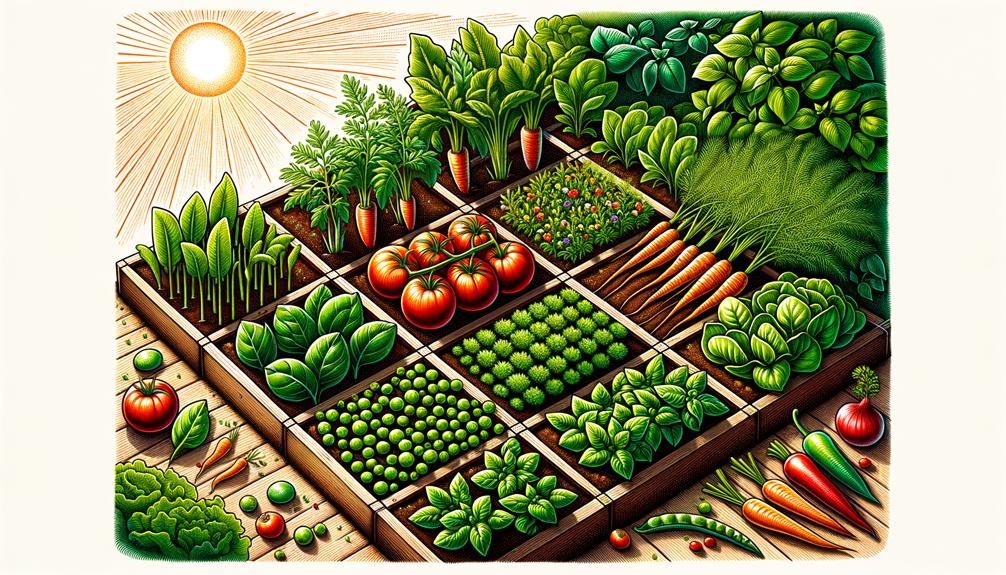You’ve got a compact space, and every inch counts, so selecting the right plants is critical to your garden’s success.
As you consider which plants will earn a spot in your garden, consider how each can contribute not only to your table but to the health and beauty of your garden ecosystem.
1. Leafy Greens: A Must-Have
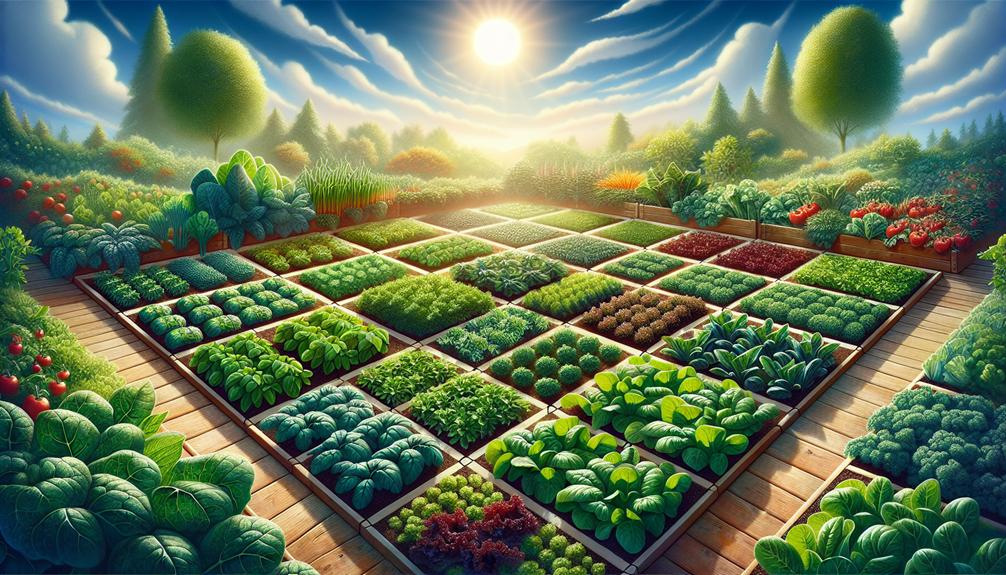
Incorporating leafy greens into your square foot garden not only maximizes space but also ensures a nutrient-rich harvest, essential for a balanced diet. You’re aiming for efficiency and abundance, but it’s crucial to manage your resources wisely.
With leafy greens, like spinach, kale, and lettuce, their shallow roots demand consistent moisture. Yet, overwatering can spell disaster. Employing a drip irrigation system or soaker hoses ensures that water reaches the roots directly, minimizing evaporation and preventing the mildew and rot that overhead watering invites.
Turning our lens to pest management, an experienced gardener like yourself knows that leafy greens attract their share of garden pests. Aphids and slugs consider your greens a feast, threatening to decimate your crop. However, strategic companion planting can significantly deter these pests. Marigolds and garlic, when planted alongside your greens, act as natural repellents. Moreover, introducing beneficial insects, such as ladybugs, to your garden ecosystem helps keep aphid populations in check.
Analyzing these techniques, it’s clear that success with leafy greens in a square foot garden hinges on diligent watering practices and proactive pest management. These methods not only safeguard your greens but also enhance your garden’s overall productivity and health.
2. Juicy Tomatoes: Square Foot Favorites
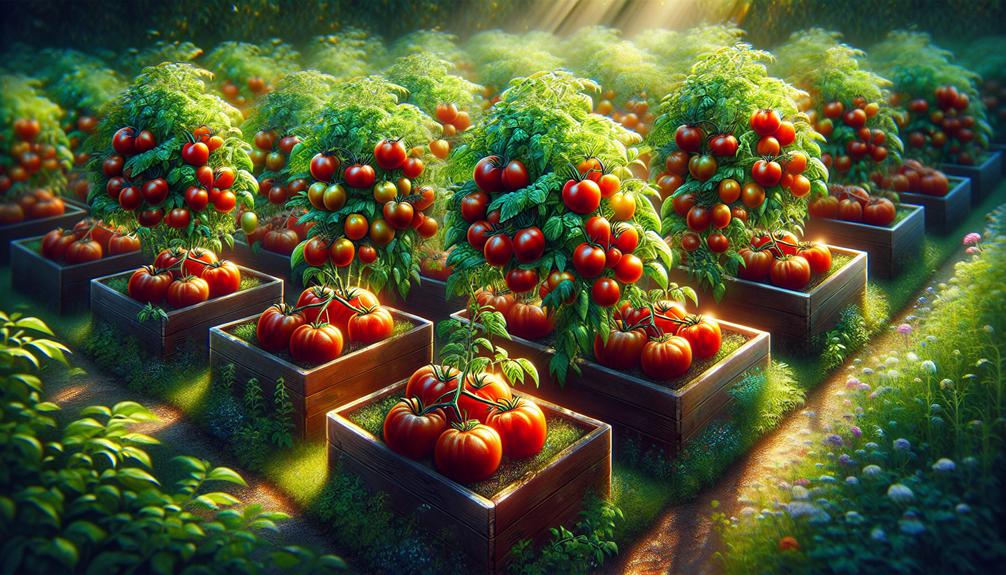
Shifting focus to juicy tomatoes, you’ll find these vibrant fruits are square foot gardening champions, thriving in well-planned spaces with attentive care. Mastering their cultivation in your square foot garden requires a blend of precision and insight, especially when it comes to mitigating common challenges and applying effective watering techniques.
Here’s a detailed look at ensuring your tomatoes flourish:
- Regular Monitoring for Pests: Tomato pests, such as hornworms and aphids, can quickly overrun your plants if not vigilantly monitored. Implementing companion planting with marigolds or basil can naturally fend off these pests, contributing to healthier, more robust tomatoes.
- Consistent, Deep Watering Technique: Tomatoes demand consistent moisture to prevent stress and diseases like blossom end rot. Drip irrigation or a soaker hose ensures water reaches the roots directly, minimizing evaporation and leaf wetness that can lead to fungal diseases.
- Staking and Support: Providing sturdy support for tomato plants encourages vertical growth, optimizing space and improving air circulation around the foliage. This practice not only enhances plant health but also makes harvesting simpler.
- Timely Pruning: Removing suckers and lower leaves promotes better air circulation and focuses the plant’s energy on fruit production rather than excessive foliage growth.
3. Crunchy Carrots: Rooted in Success
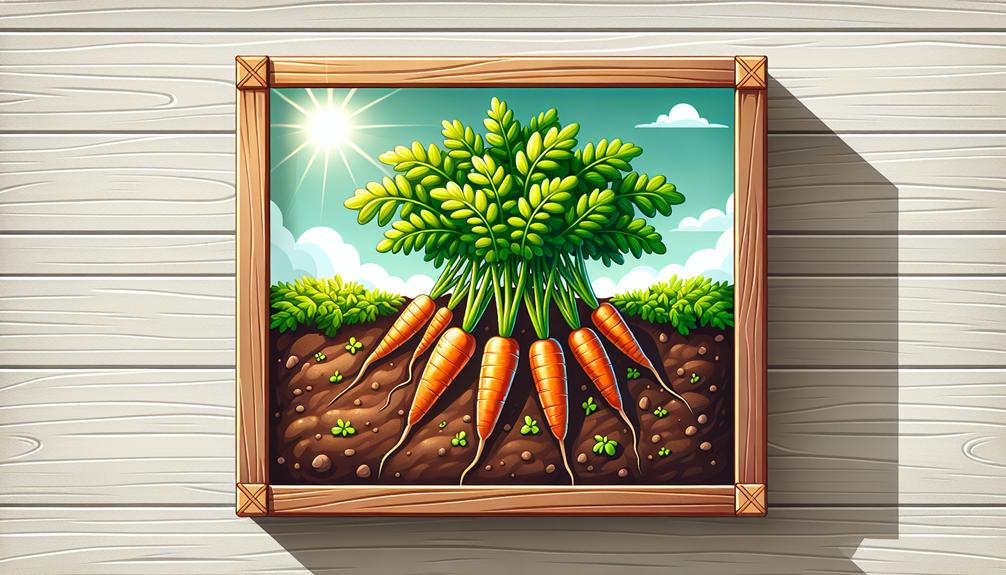
After exploring how to nurture juicy tomatoes, let’s focus on the equally rewarding task of growing crunchy carrots in your square foot garden. Selecting the right carrot varieties is crucial for success. Shorter varieties like ‘Parisian’ or ‘Nantes’ are ideal for the limited depth of square foot gardens and tend to mature faster than their longer counterparts. Each square can accommodate up to sixteen carrot plants, ensuring a bountiful harvest from a modest space.
Carrot cultivation requires a keen eye on pest control to safeguard your crop. The carrot fly poses a significant threat, especially if left unchecked. Integrated pest management strategies, such as companion planting with aromatic herbs like rosemary or sage, can deter these pests effectively. Additionally, ensuring your soil is well-drained yet retains moisture will promote healthy growth and reduce the risk of diseases.
Monitoring soil conditions, from pH to texture, plays a pivotal role in growing crunchy carrots. A slightly acidic to neutral pH and loose, sandy soil allow carrots to grow deep and straight. Regular, light watering encourages steady growth, preventing the roots from splitting. By adhering to these guidelines, you’ll ensure your square foot garden yields crunchy, flavorful carrots that are as satisfying to grow as they are to eat.
4. Sweet Strawberries: Small Space Delight
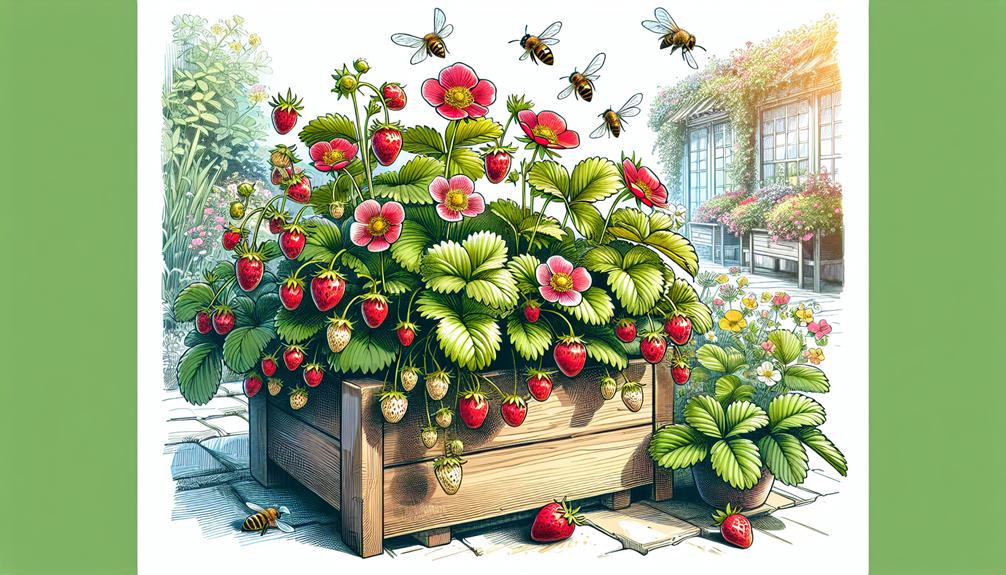
Growing sweet strawberries in a square foot garden delivers a burst of flavor and color to your small space, offering a high yield within a compact area. When cultivating these luscious fruits, understanding their needs is crucial for success. Your approach should be both strategic and attentive, focusing on maximizing productivity without sacrificing quality.
Consider these essential factors:
- Soil Acidity: Strawberries thrive in slightly acidic soil, with a pH range of 5.5 to 6.8. Testing your soil and adjusting its acidity levels ensures your plants can absorb the necessary nutrients efficiently.
- Pest Control: Keeping pests at bay is vital. Employ organic methods such as introducing beneficial insects or using natural deterrents like neem oil to protect your strawberries without resorting to harsh chemicals.
- Sunlight Exposure: These plants need full sun to produce the sweetest fruits. Position your square foot garden in a location that receives at least six to eight hours of direct sunlight daily.
- Watering Practices: Consistent moisture is key, but avoid overwatering. Implement a drip irrigation system or water carefully by hand to maintain optimal soil moisture, preventing root rot and fungal diseases.
5. Versatile Herbs: Flavorful and Compact
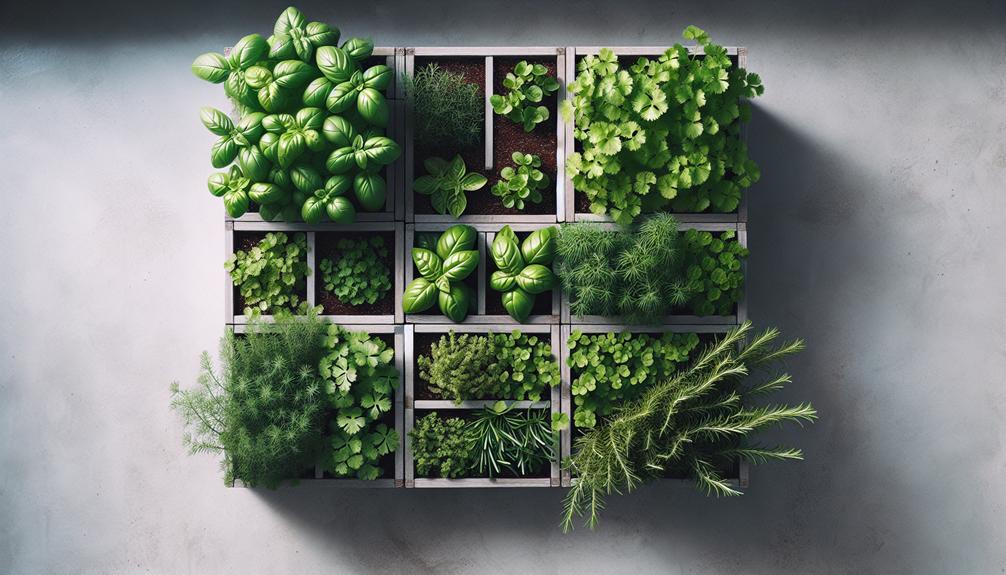
While strawberries offer a sweet burst of flavor in your square foot garden, incorporating versatile herbs can enhance both your culinary creations and the compact garden’s aromatic appeal. Herbs like basil, mint, and rosemary aren’t just culinary heroes; they’re compact powerhouses that double as herbal remedies and pest deterrents, making them indispensable in your square foot plot.
Basil, with its lush leaves and robust flavor, thrives in small spaces, requiring minimal room to flourish. It’s not just a pasta garnish; basil’s leaves have properties beneficial for herbal remedies, promoting digestive health and acting as an anti-inflammatory agent.
Similarly, mint, with its vigorous growth habit, can be contained in a square foot garden, preventing it from overtaking other plants. Its refreshing aroma isn’t just for teas or cocktails; mint acts as a natural pest deterrent, repelling unwanted insects while attracting beneficial pollinators.
Rosemary, another herb suited for compact spaces, doesn’t just add depth to dishes; its aromatic oils are revered in herbal remedies for their soothing properties. Additionally, rosemary’s strong scent serves as an effective pest deterrent, protecting neighboring plants in your square foot garden.
Incorporating these versatile herbs maximizes the utility and enjoyment of your compact garden space, blending culinary excellence with natural health benefits and pest management.
6. Peppers: Colorful and Productive
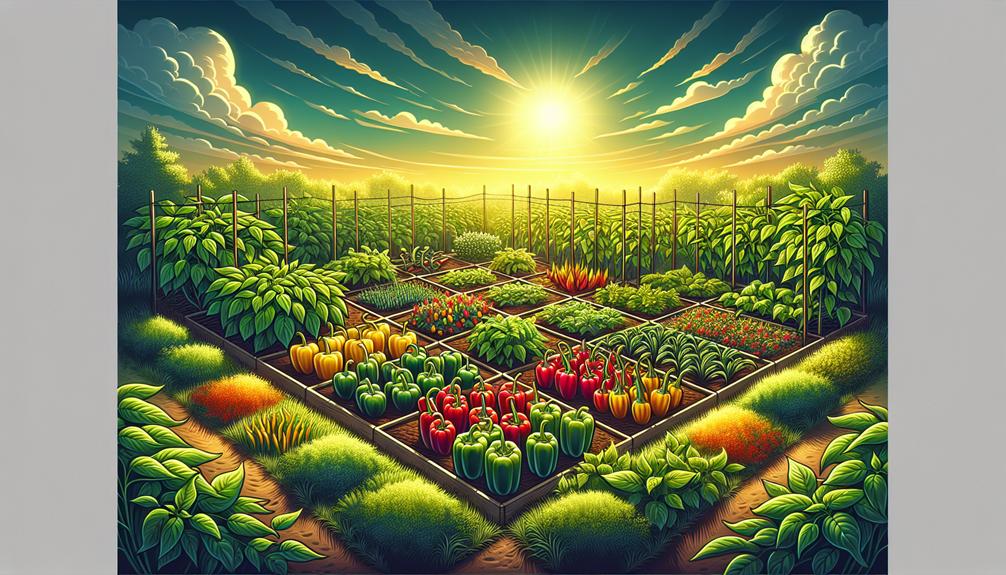
Peppers, with their vibrant hues and varied flavors, demand specific growing conditions to thrive in your square foot garden. You’ll need to ensure ample sunlight and consistent moisture to maximize their productivity and color.
Understanding the optimal time for harvesting will significantly impact their taste and yield, marking a crucial aspect of your gardening strategy.
Growing Conditions Needed
To maximize your pepper plants’ productivity and color, you’ll need to provide them with specific growing conditions tailored to their needs. Achieving peak performance involves a combination of soil amendments, water management, and constant care. Here’s how you can ensure your peppers thrive:
- Soil Amendments: Incorporate organic compost and well-rotted manure to enrich the soil. Peppers crave nutrient-rich, well-draining soil.
- Water Management: Maintain consistent moisture levels without waterlogging. Implementing a drip irrigation system can provide steady hydration.
- Sun Exposure: Ensure they receive at least 6 to 8 hours of direct sunlight daily. Sunlight is crucial for fruit development and color intensity.
- Temperature Control: Peppers prefer warm conditions. Protect them from cold drafts and consider using black plastic mulch to increase soil temperature.
Harvesting Tips
Harvesting your peppers at the right time is crucial for maximizing both their flavor and vibrant colors. When you pick peppers, it’s not just about plucking them off the plant; it’s about understanding the subtle balance between ripeness and post-harvest storage potential.
For instance, peppers harvested at their peak coloration often have the richest flavors, but if you’re aiming for longevity, slightly under-ripe peppers can withstand storage conditions better. This precision ensures a longer shelf life without sacrificing too much taste.
Moreover, effective pest management during the growing season directly influences your harvest quality. Regularly inspecting plants and adopting integrated pest management strategies can significantly reduce damage, ensuring that the peppers you harvest aren’t only vibrant and flavorful but also free from pest-induced blemishes, optimizing both immediate consumption and storage outcomes.
7. Beans: Climbing to New Heights
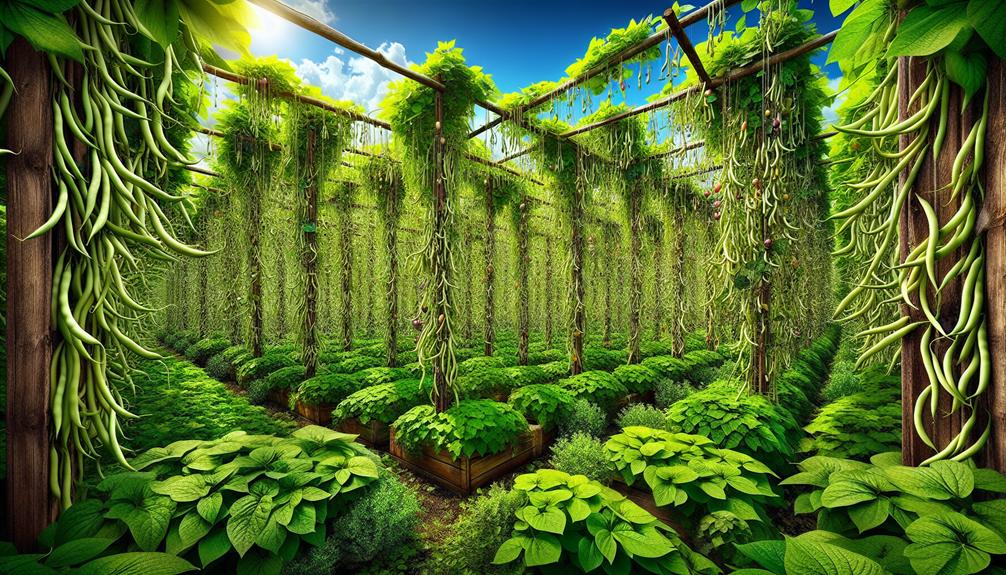
Climbing beans offer an efficient use of vertical space in your square foot garden, providing both aesthetic appeal and high yields within compact areas. When you’re planning to integrate these vigorous growers into your garden, paying attention to certain details can markedly enhance their performance and the overall health of your garden.
Incorporating climbing beans necessitates a strategic approach, especially concerning trellis designs and managing bean pests. Here’s what you need to know:
- Choose the Right Trellis: Opt for sturdy trellis designs that can support the weight of your beans as they mature. A-frame, tower, and netting structures not only maximize vertical space but also facilitate air circulation, reducing the risk of disease.
- Monitor for Pests: Regularly inspect your plants for common bean pests such as aphids, spider mites, and bean beetles. Early detection is key to preventing infestations that can compromise plant health.
- Optimal Planting Density: Don’t overcrowd your beans. Proper spacing ensures adequate airflow and accessibility for pollinators, which is crucial for fruit.
- Pruning for Health: Occasionally trimming the lower leaves can improve air circulation and minimize moisture-related diseases. This practice also makes it easier to spot and manage pests.

